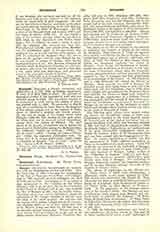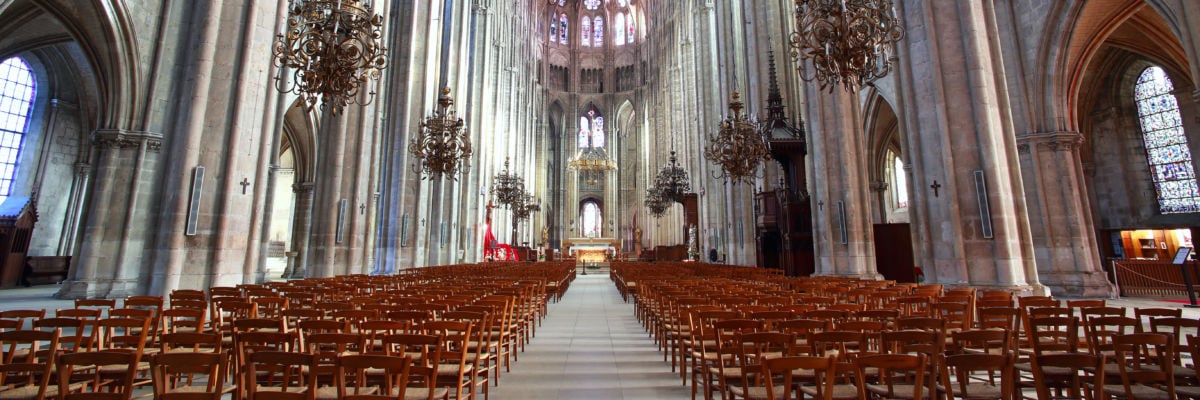

Bourges (BITURICAE), Archdiocese of, coextensive with the departments of Cher and Indre. After the Concordat of 1802 it became the metropolitan of the Sees of Clermont, Saint-Flour, and Limoges, and in 1822 received as new suffragans the Sees of Tulle and Le Puy. As Gregory of Tours assigns a date subsequent to the “mission of the twelve bishops”, that is, to the year 250, for the foundation of the Church at Bourges; and as Leo, who occupied the See of Bourges in 453, was its twelfth bishop; Duchesne, after most careful calculation, places the episcopate of St. Ursinus, founder of the see, near the close of the third century. He explains that the legend which makes Ursinus one of the seventy-two disciples seems to be of later origin than that of St. Martial, being met with for the first time in an eleventh-century manuscript. Fifteen saints figured among Leo’s successors up to the end of the ninth century: Sevitianus, Aetherius, Thecretus, Marcellus (all prior to 337); Palladius (377-384); Simplicius (472-480); Desideratus (549-550); Probianus, Felix, Remedius, and the first Sulpicius (all in the second half of the sixth century); Austregisilus (612-624); the second Sulpicius (624-644), after whom the celebrated church of St.-Sulpice in Paris was named; David (793-802); and Agilulfus (c. 820-840). Among later bishops are: St. Guillaume de Donjeon (1200-09); the celebrated theologian, Aegidius a Columnis (1298-1316); and Jean Coeur (1447-83), son of the treasurer Jacques Coeur and during whose episcopate the University of Bourges was founded.
The claims of the See of Bourges to the primacy in Aquitaine are treated at length in the article on Bordeaux. Pope Clement V (1305-14) opposed these claims; nevertheless the See of Bourges always prided itself upon a sort of platonic supremacy, and when, in 1678, the Bishop of Albi became Archbishop, he recognized explicitly the claims of Bourges. Even today the Archbishop of Bourges retains the title of Primate of Aquitaine; in this way, the name of Aquitaine which, after the thirteenth century, disappeared from political geography (being replaced by that of Guyenne) has been perpetuated in the terminology of the Church. In 1107 Pascal II, and in 1163 Alexander III, visited the Diocese of Bourges. Many councils were held at Bourges, the principal among them being those of 1225 and 1226 which dealt with the Albigenses; that of 1438, after which Charles VII promulgated the Pragmatic Sanction whereby the decrees of Basle were ratified in France, and the organization of a Gallican Church was attempted; and the council of 1528 which combated the Protestant encroachments favored at Bourges on the one side by the university in which Calvin and Theodore Beza studied, and on the other by the court of Margaret of Valois.
The following great abbeys were located within the diocese: the Benedictine Abbey of Deols near Chateauroux, founded in the tenth century, where St. Lusorius, son of the senator Leocadius, was interred; the Abbey of St.-Satur near Sancerre, founded in 463; and that of Chezal-Benoit founded in 1098 by Blessed Andre of Vallombrosa, and mother-house of the great Benedictine congregation which included the Parisian Abbey of St.-Germain-des-Pres and was later merged into the Congregation of St.-Maur. St. Leman, Archbishop of Seville, who fled the persecutions of Totila, suffered martyrdom at Vatan in the middle of the sixth century. Louis VII (1120-80) was crowned in the Cathedral of Bourges, and Louis XI (1423-83) and the great Conde (1621-86) were baptized at Bourges. Labbe, author of the “Collection of Councils” (1607-67) and Bourdaloue, the illustrious preacher (1632-1704) both Jesuits, were born at Bourges. The Cathedral of Bourges (thirteenth century) has beautiful windows and its sacristy (fifteenth century) was built at the expense of Jacques Coeur.
The places of pilgrimages in the diocese are: (I) Notre Dame of Deols near Chateauroux, a pilgrimage begun in the tenth century by Ebbo. The church was consecrated by Pascal II. Pope Alexander III when in exile lived there and received Henry II of England; Pope Honorius III visited it. (2) Notre Dame du Bien Mourir at Fontgombault. (3) The pilgrimage of Ste.—Solange, patron saint of the County of Berry. Ste.—Solange was born at Villemont, three leagues from Bourges, and suffered death to preserve her virginity. (4) Notre Dame du Sacre Coeur at Issoudun. (5) Notre Dame de Pellevoisin, famous for the visions that date back to 1876 and concerning which ecclesiastical authority is still silent.
In 1899, the following institutions were found in the archdiocese: 36 infant schools in Cher and 29 in Indre, conducted by sisters, 3 girls’ orphanages in Cher and 2 in Indre, 1 house of refuge for young women in Cher, 2 patronages for girls in Cher, 20 hospitals or hospices in Cher and 14 in Indre, 5 communities for the care of the sick in their homes in Cher and 4 in Indre, 1 insane asylum in Cher, 6 homes for the aged in Cher and 2 in Indre, 1 orphanage for deaf-mute and blind girls in Indre, and 1 home for incurables in Indre, all conducted by nuns.
In 1900 the religious orders of men in the diocese were: Jesuits and Franciscans at Bourges; Trappists at Fontgombault. The societies peculiar to the diocese were: Men: Missionaries of the Sacred Heart, founded in 1854 with the mother-house at Issoudun. This house is the center of the universal Archconfraternity of Our Lady of the Sacred Heart which has vicariates Apostolic in Oceanica. Women: (I) Benedictines of the Holy Sacrament or of St. Laurence, a congregation said to date back to the time of Charlemagne. They are Sisters of the Perpetual Adoration and teachers. (2) Sisters of Charity and of the Holy Sacrament, called de Montoire, with the mother-house at Bourges. This congregation, founded in 1662 by Antoine Moreau, devotes itself to teaching and hospital nursing. It has 150 houses of which 106 are in the Diocese of Bourges. (3) Religious of the Immaculate Mary, hospital nurses and teachers, with the mother-house at Bourges. After the Revolution, the congregation took the place of the lay confraternity of the Immaculate Mary, and, subsequent to 1857 had charge of the general hospital. (4) Daughters of the Sacred Heart of Issoudun with houses in Belgium and Australia. At the close of 1905 the Archdiocese of Bourges had 652,681 inhabitants, 65 pastorates 430 succursal parishes (mission churches), and 28 curacies.
GEORGES GOYAU


